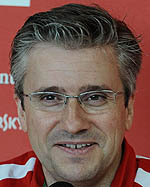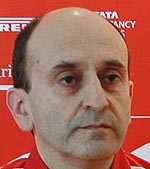 Ferrari Technical Director, Pat Fry and Head of Engine and Electronics, Luca Marmorini, talk about the F138.
Ferrari Technical Director, Pat Fry and Head of Engine and Electronics, Luca Marmorini, talk about the F138.
As Technical Director, Fry is not only ultimately responsible for the F138 but also for the workforce that has produced it. "Among the changes made to our structure has been the appointment of two Deputy Chief Designers," explained the Englishman. "With some big changes coming through it's a better way to organise ourselves, when we need to run two concurrent car projects.
"This year's car is more of an evolution than a revolution, based on similar concepts to the F2012 and in all the little areas of performance where we think we can gain something, we have looked for those gains. The car has changed in subtle ways, some areas more than others, but in general, the F138 is a development of last year's car."
Like Red Bull, Ferrari was involved in a fight to the wire last season, which meant that work on the 2013 car was delayed however, Fry isn't overly concerned. "I think that is something that all the top teams will say," he says. "In a way we were fortunate that we had already made the previously mentioned changes to our structure, as we were able to keep pushing on with last year's car, while still being in reasonable shape for developing this year's one.
"The biggest challenge was the aerodynamic side of things, as we started maybe three months later than is normal. We have quite a lot of catching up to do and you will see quite a lot of changes coming after the launch car: we will have some new parts for the second test and then another big upgrade for the third and final one, so lots of changes coming through."
Another effect of the future on the present is that not much of this year's work will be useful in 2012 when the new rgulations come into affect. "The fact that the 2014 car will be very different - aerodynamically the exhaust effect is changed with the turbo and exhaust positions being different, the front wing development will be new, while the rear wing constitutes another major change - means that a lot of our 2013 work will not carry over, which will put an increased work load on aero departments and the design department as well," he admits.
"However, I think the design side is working very well with the changes we made, working in conjunction with the power unit team. Having said that, there's a huge amount of work to do on both car projects and we have to get to work early on the 2014 car to be in a good position.
"We have reviewed all last year's races, to see what we did right and what we did wrong, in terms of strategy and we need to learn from that," he continues. "We are trying to improve our pit stops still further and we have made some changes in that area. Hopefully we can gain another couple of tenths off our pit stop time. On average, we were consistently the best in this area last year, but you cannot afford to stand still, otherwise you find yourself dropping behind: we need to catch up to the level of teams that were quicker in pure speed terms even if they had more problems at their pit stops.
"We could say we were lucky at times last year on the reliability front, but you make your own luck and it reflects on the amount of work done back here at the factory: we must continue to work to be as good or even better on this front this year."
Asked if he is pleased with the F138, Fry eventually responds: "In the last eighteen months to two years we have made major changes to our methodology and we are partway through a process and I am pleased with the progress we have made so far. But for me, our progress can never be quick enough and I feel we still have quite a lot to do to improve.
"I am never going to be happy unless we arrive in Melbourne and prove to have the quickest car. In terms of the launch car, we have done a good job on the mechanical installation and the design, we have hit all our stiffness targets and saved a lot of weight. However, we cannot hide the fact that, aerodynamically, the launch car is a long way behind where we are in the wind tunnel today. We will have a better idea of what our true performance level is come the third test but I'm not going to be happy until we are clearly quickest."
 The regulations have frozen engine development for several years now, but this has not stopped the specialist engineers from using all their ingenuity to continue improving the engines that power the cars. And that is the case, even as Formula 1 embarks on its eighth and final season in which all cars must use the V8 configuration.
The regulations have frozen engine development for several years now, but this has not stopped the specialist engineers from using all their ingenuity to continue improving the engines that power the cars. And that is the case, even as Formula 1 embarks on its eighth and final season in which all cars must use the V8 configuration.

 Ferrari Technical Director, Pat Fry and Head of Engine and Electronics, Luca Marmorini, talk about the F138.
Ferrari Technical Director, Pat Fry and Head of Engine and Electronics, Luca Marmorini, talk about the F138. The regulations have frozen engine development for several years now, but this has not stopped the specialist engineers from using all their ingenuity to continue improving the engines that power the cars. And that is the case, even as Formula 1 embarks on its eighth and final season in which all cars must use the V8 configuration.
The regulations have frozen engine development for several years now, but this has not stopped the specialist engineers from using all their ingenuity to continue improving the engines that power the cars. And that is the case, even as Formula 1 embarks on its eighth and final season in which all cars must use the V8 configuration.



















sign in